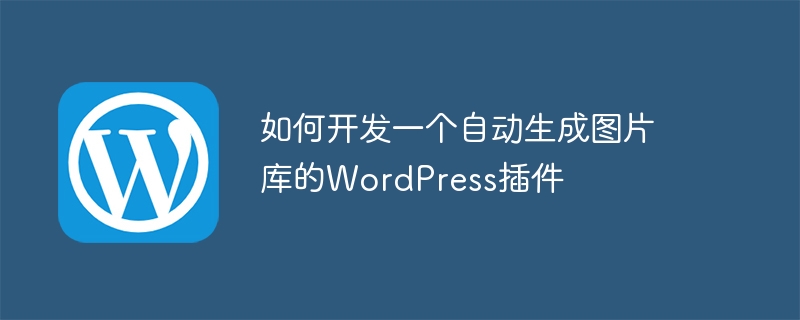Home >CMS Tutorial >WordPress >How to develop a WordPress plugin that automatically generates image galleries
How to develop a WordPress plugin that automatically generates image galleries
- PHPzOriginal
- 2023-09-05 11:54:21898browse

How to develop a WordPress plug-in that automatically generates a picture library
With the development of the mobile Internet, pictures have become a common medium for us to express and transmit information online. In the process of establishing and maintaining a personal blog, we usually need a picture library to manage and display our picture resources. In order to facilitate the use of WordPress blog users, this article will introduce how to develop a WordPress plug-in that automatically generates image libraries, and provide code examples.
First, we need to create the infrastructure of a WordPress plugin. In your WordPress plugin directory, create a new folder and create a plugin master file in it, named image-library.php. In the main file, we need to define the basic information and initialization function of the plug-in.
<?php
/*
Plugin Name: 图片库
Plugin URI: https://www.example.com
Description: 一个自动生成图片库的WordPress插件
Version: 1.0
Author: Your Name
Author URI: https://www.example.com
License: GPL2
*/
// 初始化插件
function image_library_init() {
// 在这里添加插件的初始化逻辑
}
add_action('init', 'image_library_init');Next, we need to add a custom database table to store image information. In order to simplify the development process, we use the wpdb class that comes with WordPress to perform database operations.
// 创建数据库表
function image_library_create_table() {
global $wpdb;
$table_name = $wpdb->prefix . 'image_library'; // 添加表前缀
$charset_collate = $wpdb->get_charset_collate();
$sql = "CREATE TABLE $table_name (
id mediumint(9) NOT NULL AUTO_INCREMENT,
title text NOT NULL,
file_url text NOT NULL,
PRIMARY KEY (id)
) $charset_collate;";
require_once( ABSPATH . 'wp-admin/includes/upgrade.php' );
dbDelta( $sql ); // 创建表
}
register_activation_hook( __FILE__, 'image_library_create_table' );Next, we need to add a menu item in the WordPress backend so that users can enter the image library management interface. You can use the add_menu_page function to achieve this function.
// 添加菜单项
function image_library_add_menu() {
add_menu_page(
'图片库',
'图片库',
'manage_options',
'image-library',
'image_library_menu',
'dashicons-format-gallery',
25
);
}
add_action('admin_menu', 'image_library_add_menu');Then, we need to create the interface corresponding to the menu. In this interface, we can display a list of all images and provide functions for uploading and deleting images.
// 图片库管理界面
function image_library_menu() {
if (!current_user_can('manage_options')) {
wp_die(__('您没有权限访问该页面。'));
}
// 添加上传图片逻辑
if (isset($_POST['submit'])) {
$title = sanitize_text_field($_POST['title']);
$file_url = sanitize_text_field($_POST['file_url']);
global $wpdb;
$table_name = $wpdb->prefix . 'image_library';
$wpdb->insert($table_name, array('title' => $title, 'file_url' => $file_url));
echo '<div class="notice notice-success"><p>图片上传成功!</p></div>';
}
// 添加删除图片逻辑
if (isset($_GET['delete']) && isset($_GET['nonce'])) {
if (!wp_verify_nonce($_GET['nonce'], 'delete_image')) {
wp_die(__('非法请求。'));
}
$id = intval($_GET['delete']);
global $wpdb;
$table_name = $wpdb->prefix . 'image_library';
$wpdb->delete($table_name, array('id' => $id));
echo '<div class="notice notice-success"><p>图片删除成功!</p></div>';
}
// 展示图片列表
global $wpdb;
$table_name = $wpdb->prefix . 'image_library';
$images = $wpdb->get_results("SELECT * FROM $table_name");
echo '<div class="wrap">';
echo '<h1>图片库管理</h1>';
echo '<form method="post">';
echo '<table class="wp-list-table widefat fixed striped">';
echo '<thead><tr><th>标题</th><th>图片链接</th><th>操作</th></tr></thead>';
echo '<tbody>';
foreach ($images as $image) {
echo '<tr>';
echo '<td>' . $image->title . '</td>';
echo '<td><a href="' . $image->file_url . '">' . $image->file_url . '</a></td>';
echo '<td><a href="?page=image-library&delete=' . $image->id . '&nonce=' . wp_create_nonce('delete_image') . '">删除</a></td>';
echo '</tr>';
}
echo '</tbody>';
echo '</table>';
echo '<h2>上传图片</h2>';
echo '<label>标题:<input type="text" name="title" required></label><br>';
echo '<label>图片链接:<input type="text" name="file_url" required></label><br>';
echo '<input type="submit" name="submit" value="上传">';
echo '</form>';
echo '</div>';
}Finally, we need to add a shortcode to the image gallery to embed images in posts or pages.
// 图片库短代码
function image_library_shortcode($atts) {
ob_start();
global $wpdb;
$table_name = $wpdb->prefix . 'image_library';
$images = $wpdb->get_results("SELECT * FROM $table_name");
echo '<div class="image-library">';
foreach ($images as $image) {
echo '<div class="image-item">';
echo '<h3>' . $image->title . '</h3>';
echo '<img src="' . $image- alt="How to develop a WordPress plugin that automatically generates image galleries" >file_url . '">';
echo '</div>';
}
echo '</div>';
return ob_get_clean();
}
add_shortcode('image-library', 'image_library_shortcode');Now, we have completed the development of the WordPress plug-in that automatically generates image libraries. You can save the above code into the main plugin file image-library.php and place the file in your WordPress plugin directory. Then, activate the plug-in on the WordPress backend plug-in management page.
When developing plug-ins, pay attention to following WordPress development specifications as much as possible, and provide users with a friendly interface and operating experience. I hope this article can help you develop WordPress plug-ins!
The above is the detailed content of How to develop a WordPress plugin that automatically generates image galleries. For more information, please follow other related articles on the PHP Chinese website!

